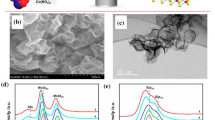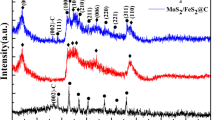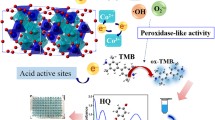Abstract
Nanozymes are next-generation of nanomaterials with enzyme-like activities. In particular, nanozymes with peroxidase (POD)-like activity have been utilized in various fields, including antibacterial, detection, degradation, etc. However, their extensive applications were limited by their low catalytic activity currently. Herein, we have presented a composite nanozyme based on attapulgite (ATP) (Fe-ATP-MoS2 (FAM)), which exhibited enhanced POD-like activity (185.33 U·mg−1), 4.25 times higher than that of Fe-MoS2 (FM) (43.63 U·mg−1). The density functional theory (DFT) calculations indicated that the addition of ATP increased the electron density of metal centers (Mo and Fe). More importantly, Michaelis–Menten kinetics revealed that the introduction of ATP significantly enhanced the binding affinities of substrates through the pores of ATP, forming a highly concentrated substrate microenvironment and thus promoting its POD-like activity. Additionally, from molecular size and kinetic analysis, we proposed that the changes in substrate size before and after oxidation also significantly affected its Michaelis-constant (Km) value. Furthermore, we utilized FAM in the applications of highly effective antibacterial application and sensitive detection of glutathione (GSH). In conclusion, this work provides a novel approach for designing a highly efficient nanozyme based on natural mineral composites.

Similar content being viewed by others
References
Liang, M. M.; Yan, X. Y. Nanozymes: From new concepts, mechanisms, and standards to applications. Acc. Chem. Res. 2019, 52, 2190–2200.
Robert, A.; Meunier, B. How to define a nanozyme. ACS Nano 2022, 16, 6956–6959.
Gao, L. Z.; Zhuang, J.; Nie, L.; Zhang, J. B.; Zhang, Y.; Gu, N.; Wang, T. H.; Feng, J.; Yang, D. L.; Perrett, S. et al. Intrinsic peroxidase-like activity of ferromagnetic nanoparticles. Nat. Nanotechnol. 2007, 2, 577–583.
Qiu, Z. W.; Duan, W.; Cao, S. F.; Zeng, T.; Zhao, T. Y.; Huang, J. K.; Lu, X. Q.; Zeng, J. B. Highly specific colorimetric probe for fluoride by triggering the intrinsic catalytic activity of a AgPt-Fe3O4 hybrid nanozyme encapsulated in SiO2 shells. Environ. Sci. Technol. 2022, 56, 1713–1723.
Shen, Y. Z.; Wei, Y. L.; Gao, X.; Nie, C.; Wang, J. L.; Wu, Y. N. Engineering an enzymatic cascade catalytic smartphone-based sensor for onsite visual ratiometric fluorescence-colorimetric dual-mode detection of methyl mercaptan. Environ. Sci. Technol. 2023, 57, 1680–1691.
Chandio, I.; Ai, Y. J.; Wu, L.; Liang, Q. L. Recent progress in MOFs-based nanozymes for biosensing. Nano Res. 2024, 17, 39–64.
Huang, Y. Y.; Ren, J. S.; Qu, X. G. Nanozymes: Classification, catalytic mechanisms, activity regulation, and applications. Chem. Rev. 2019, 119, 4357–4412.
Zhu, Y. L.; Wang, Z.; Zhao, R. X.; Zhou, Y. H.; Feng, L. L.; Gai, S. L.; Yang, P. P. Pt decorated Ti3C2Tx MXene with NIR-II light amplified nanozyme catalytic activity for efficient phototheranostics. ACS Nano 2022, 16, 3105–3118.
Hong, J. J.; Guo, Z. J.; Duan, D. H.; Zhang, Y.; Chen, X.; Li, Y. J.; Tu, Z.; Feng, L.; Chen, L.; Yan, X. Y. et al. Highly sensitive nanozyme strip: An effective tool for forensic material evidence identification. Nano Res. 2024, 17, 1785–1791.
Kumari, A.; Sahoo, J.; De, M. 2D-MoS2-supported copper peroxide nanodots with enhanced nanozyme activity: Application in antibacterial activity. Nanoscale 2023, 15, 19801–19814.
Guo, Z. J.; Hong, J. J.; Song, N. N.; Liang, M. M. Single-atom nanozymes: From precisely engineering to extensive applications. Acc. Mater. Res. 2024, 5, 347–357.
Wang, Z. W.; Wang, W. L.; Wang, J.; Wang, D. S.; Liu, M. L.; Wu, Q. Y.; Hu, H. Y. Single-atom catalysts with ultrahigh catalase-like activity through electron filling and orbital energy regulation. Adv. Funct. Mater. 2023, 33, 2209560.
Fan, Y.; Yi, Y.; Rong, H. P.; Zhang, J. T. Silicon dioxide-protection boosting the peroxidase-like activity of Fe single-atom catalyst for combining chemo-photothermal therapy. Nano Res. 2024, 17, 4924–4933.
Mei, L. Q.; Zhu, S.; Liu, Y. P.; Yin, W. Y.; Gu, Z. J.; Zhao, Y. L. An overview of the use of nanozymes in antibacterial applications. Chem. Eng. J. 2021, 418, 129431.
Pang, H. H.; Ke, Y. C.; Li, N. S.; Chen, Y. T.; Huang, C. Y.; Wei, K. C.; Yang, H. W. A new lateral flow plasmonic biosensor based on gold-viral biomineralized nanozyme for on-site intracellular glutathione detection to evaluate drug-resistance level. Biosens. Bioelectron. 2020, 165, 112325.
Zhu, Z. L.; Du, S. S.; Du, Y. B.; Ren, J.; Ying, G. G.; Yan, Z. Glutathione reductase mediates drug resistance in glioblastoma cells by regulating redox homeostasis. J. Neurochem. 2018, 144, 93–104.
Esme, H.; Cemek, M.; Sezer, M.; Saglam, H.; Demir, A.; Melek, H.; Unlu, M. High levels of oxidative stress in patients with advanced lung cancer. Respirology 2008, 13, 112–116.
Singh, P.; Ojha, R. P.; Kumar, S.; Singh, A. K.; Prakash, R. Fe-doped MoS2 nanomaterials with amplified peroxidase mimetic activity for the colorimetric detection of glutathione in human serum. Mater. Chem. Phys. 2021, 267, 124684.
Wang, K.; Sun, S. Y.; Golubev, Y. A.; Lin, S.; Liu, J.; Dong, F. Q.; Kotova, E. L.; Kotova, O. B. Intrinsic peroxidase-like clay mineral nanozyme-triggered cascade bioplatform with enhanced catalytic performance. Appl. Clay Sci. 2023, 246, 107196.
Bao, W. X.; Tian, L. Y.; Wang, H.; Tang, A. D.; Yang, H. M. Breaking through the pH limitation of Fe1−xS nanozymes using component-modulated coupled nanoclay. Inorg. Chem. 2024, 63, 3366–3375.
Wang, H.; Sarwar, M. T.; Tian, L. Y.; Bao, W. X.; Yang, H. M. Nanoclay modulates cation occupancy in manganese ferrite for catalytic antibacterial treatment. Inorg. Chem. 2022, 61, 17692–17702.
Feng, F.; Zhang, X.; Mu, B.; Wang, P. X.; Chen, Z. S.; Zhang, J. H.; Zhang, H. F.; Zhuang, J. L.; Zhao, L.; An, Q. et al. Attapulgite doped with Fe and Cu nanooxides as peroxidase nanozymes for antibacterial coatings. ACS Appl. Nano Mater. 2022, 5, 16720–16730.
Peng, K.; Fu, L. J.; Ouyang, J.; Yang, H. M. Emerging parallel dual 2D composites: Natural clay mineral hybridizing MoS2 and interfacial structure. Adv. Funct. Mater. 2016, 26, 2666–2675.
Li, Y.; Fu, R. Z.; Duan, Z. G.; Zhu, C. H.; Fan, D. D. Construction of multifunctional hydrogel based on the tannic acid-metal coating decorated MoS2 dual nanozyme for bacteria-infected wound healing. Bioact Mater. 2022, 9, 461–474.
Liang, Y. L.; Yoo, H. D.; Li, Y. F.; Shuai, J.; Calderon, H. A.; Robles Hernandez, F. C.; Grabow, L. C.; Yao, Y. Interlayer-expanded molybdenum disulfide nanocomposites for electrochemical magnesium storage. Nano Lett. 2015, 15, 2194–2202.
Zhou, C. Z.; Li, Z. P.; Liu, S. W.; Zhan, T. R.; Li, W. Q.; Wang, J. Q. Layered double hydroxides for tribological application: Recent advances and future prospective. Appl. Clay Sci. 2022, 221, 106466.
Khawula, T. N. Y.; Raju, K.; Franklyn, P. J.; Sigalas, I.; Ozoemena, K. I. Symmetric pseudocapacitors based on molybdenum disulfide (MoS2)-modified carbon nanospheres: Correlating physicochemistry and synergistic interaction on energy storage. J. Mater. Chem. A 2016, 4, 6411–6425.
Feng, L. P.; Zhang, L. X.; Zhang, S.; Chen, X.; Li, P.; Gao, Y.; Xie, S. J.; Zhang, A. C.; Wang, H. Plasma-assisted controllable doping of nitrogen into MoS2 nanosheets as efficient nanozymes with enhanced peroxidase-like catalysis activity. ACS Appl. Mater. Interfaces 2020, 12, 17547–17556.
Feng, W.; Chen, L.; Qin, M.; Zhou, X. J.; Zhang, Q. Q.; Miao, Y. K.; Qiu, K. X.; Zhang, Y. Z.; He, C. L. Flower-like PEGylated MoS2 nanoflakes for near-infrared photothermal cancer therapy. Sci. Rep. 2015, 5, 17422.
Hirata, T. In-situ observation of Mo–O stretching vibrations during the reduction of MoO3 with hydrogen by diffuse reflectance FTIR spectroscopy. Appl. Surf. Sci. 1989, 40, 179–181.
Hassan, A.; Macedo, L. J. A.; de Souza, J. C. P.; Lima, F. C. D. A.; Crespilho, F. N. A combined Far-FTIR, FTIR spectromicroscopy, and DFT study of the effect of DNA binding on the [4Fe4S] cluster site in endoIII. Sci. Rep. 2020, 10, 1931.
Wang, D.; Wang, Y. Q.; Chen, X. D.; Zhu, Y. K.; Zhan, K.; Cheng, H. B.; Wang, X. Y. Layer-by-layer thinning of two-dimensional MoS2 films by using a focused ion beam. Nanoscale 2016, 8, 4107–4112.
Wu, L. H.; Luo, Y.; Wang, C. F.; Wu, S. L.; Zheng, Y. F.; Li, Z. Y.; Cui, Z. D.; Liang, Y. Q.; Zhu, S. L.; Shen, J. et al. Self-driven electron transfer biomimetic enzymatic catalysis of bismuth-doped PCN-222 MOF for rapid therapy of bacteria-infected wounds. ACS Nano 2023, 17, 1448–1463.
Yu, F. Q.; Huang, Y. Z.; Cole, A. J.; Yang, V. C. The artificial peroxidase activity of magnetic iron oxide nanoparticles and its application to glucose detection. Biomaterials 2009, 30, 4716–4722.
Jiang, B.; Duan, D. M.; Gao, L. Z.; Zhou, M. J.; Fan, K. L.; Tang, Y.; Xi, J. Q.; Bi, Y. H.; Tong, Z.; Gao, G. F. et al. Standardized assays for determining the catalytic activity and kinetics of peroxidase-like nanozymes. Nat. Protoc. 2018, 13, 1506–1520.
Hao, J. Y.; Zhang, C.; Feng, C. X.; Wang, Q.; Liu, Z. Y.; Li, Y.; Mu, J. S.; Yang, E. C.; Wang, Y. An ultra-highly active nanozyme of Fe,N co-doped ultrathin hollow carbon framework for antibacterial application. Chin. Chem. Lett. 2023, 34, 107650.
Wang, L. W.; Gao, F. N.; Wang, A. Z.; Chen X. Y.; Li, H.; Zhang, X.; Zheng, H.; Ji, R.; Li, B.; Yu, X. et al. Defect-rich adhesive molybdenum disulfide/rGO vertical heterostructures with enhanced nanozyme activity for smart bacterial killing application. Adv. Mater. 2020, 32, 2005423.
Aneesh, K.; Vusa, C. S. R.; Berchmans, S. Enhanced peroxidase-like activity of CuWO4 nanoparticles for the detection of NADH and hydrogen peroxide. Sens. Actuators B Chem. 2017, 253, 723–730.
Zhao, Z. Q.; Sun, C.; Li, Y.; Yu, Q. L.; Jin, Z.; Wang, M. W.; Liang, L. F.; Zhang, Y. B. Driving microbial sulfur cycle for phenol degradation coupled with Cr(VI) reduction via Fe(III)/Fe(II) transformation. Chem. Eng. J. 2020, 393, 124801.
Su, L. N.; Wang, P. F.; Ma, X. L.; Wang, J. H.; Zhan, S. H. Regulating local electron density of iron single sites by introducing nitrogen vacancies for efficient photo-fenton process. Angew. Chem., Int. Ed. 2021, 60, 21261–21266.
Wang, Z. H.; Wu, F. G. Emerging single-atom catalysts/nanozymes for catalytic biomedical applications. Adv. Healthcare Mater. 2022, 11, 2101682.
Zhang, X. Y.; Zhang, S. T.; Yang, Z. X.; Wang, Z. H.; Tian, X.; Zhou, R. H. Self-cascade MoS2 nanozymes for efficient intracellular antioxidation and hepatic fibrosis therapy. Nanoscale 2021, 13, 12613–12622.
Zhu, H. J.; Zan, W. Y.; Chen, W. L.; Jiang, W. B.; Ding, X. G.; Li, B. L.; Mu, Y. W.; Wang, L.; Garaj, S.; Leong, D. T. Defect-rich molybdenum sulfide quantum dots for amplified photoluminescence and photonics-driven reactive oxygen species generation. Adv. Mater. 2022, 34, 2200004.
Dong, H. J.; Du, W.; Dong, J.; Che, R. C.; Kong, F.; Cheng, W. L.; Ma, M.; Gu, N.; Zhang, Y. Depletable peroxidase-like activity of Fe3O4 nanozymes accompanied with separate migration of electrons and iron ions. Nat. Commun. 2022, 13, 5365.
Yang, H. M.; Tang, A. D.; Ouyang, J.; Li, M.; Mann, S. From natural attapulgite to mesoporous materials: Methodology, characterization and structural evolution. J. Phys. Chem. B 2010, 114, 2390–2398.
Song, N. N.; Yu, Y.; Zhang, Y. N.; Wang, Z. D.; Guo, Z. J.; Zhang, J. L.; Zhang, C. B.; Liang, M. M. Bioinspired hierarchical self-assembled nanozyme for efficient antibacterial treatment. Adv. Mater. 2024, 16, 2210455.
Kim, T. I.; Kwon, B.; Yoon, J.; Park, I. J.; Bang, G. S.; Park, Y.; Seo, Y. S.; Choi, S. Y. Antibacterial activities of graphene oxide-molybdenum disulfide nanocomposite films. ACS Appl. Mater. Interfaces 2017, 9, 7908–7917.
Ranji-Burachaloo, H.; Karimi, F.; Xie, K.; Fu, Q.; Gurr, P. A.; Dunstan, D. E.; Qiao, G. G. MOF-mediated destruction of cancer using the cell’s own hydrogen peroxide. ACS Appl. Mater. Interfaces 2017, 9, 33599–33608.
Djorić, D.; Kristich, C. J. Oxidative stress enhances cephalosporin resistance of Enterococcus faecalis through activation of a two-component signaling system. Antimicrob. Agents Chemother. 2014, 59, 159–169.
Acknowledgements
This work was supported by the National Natural Science Foundation of China (Nos. 52072347 and 22272152), the Foundation of Key Laboratory of Clay Mineral Applied Research of Gansu Province, Lanzhou Institute of Chemical Physics, Chinese Academy of Sciences (No. CMAR-2022-04), and Beijing Nova project (No. 20220484155).
Author information
Authors and Affiliations
Corresponding authors
Electronic Supplementary Material
12274_2024_6685_MOESM1_ESM.pdf
Enhancing the peroxidase-like activity of MoS2-based nanozymes by introducing attapulgite for antibacterial application and sensitive detection of glutathione
Rights and permissions
About this article
Cite this article
Feng, F., Zhang, Y., Zhang, X. et al. Enhancing the peroxidase-like activity of MoS2-based nanozymes by introducing attapulgite for antibacterial application and sensitive detection of glutathione. Nano Res. (2024). https://doi.org/10.1007/s12274-024-6685-3
Received:
Revised:
Accepted:
Published:
DOI: https://doi.org/10.1007/s12274-024-6685-3




